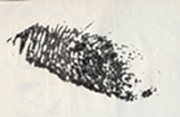Doubt in the Darlie Routier case: The subjective science (part 2)
September 9, 2012 2 Comments
Two years after providing testimony on behalf of the prosecution at Darlie Routier’s 1997 trial, bloodstain pattern analyst Tom Bevel was involved in a case where the accused was arrested, convicted, denied multiple appeals, and then granted a retrial that resulted in his release from prison three decades after the original crime occurred. The man’s name is Tim Masters and he was only 15 years old when 37 year-old Peggy Hettrick was murdered in Fort Collins, Colorado.
In February of 1987, Peggy ended her shift at work around 9 p.m. at a local clothing store. She had acquired a temporary roommate and she had given her the only key she had. Her roommate had gotten drunk and passed out, oblivious to Peggy’s banging on the door. Upon realizing she was locked out of her residence, Peggy went to a couple of bars and then returned home to get her key from the roommate. She changed her clothes and then returned to one of the bars just before midnight. Peggy did not have a vehicle and so she relied on walking or obtaining rides from others.
At the time of Peggy’s murder she was seeing a man named Matt Zoellner. On the evening in question, Peggy and Zoellner had an argument when she spotted him at the Prime Minister Pub with another woman. She became extremely upset and left. This was the last time anyone reported seeing Peggy alive before her partially nude body was discovered the following morning by a person riding a bike. She was found near a curb that led into a field, with her breasts exposed, her jeans and panties pulled down to her knees, and the straps of her purse still twisted around her arm. She had been stabbed and mutilated.
The Investigation
At the time Peggy was found in the field, 15 year-old Tim lived with his father in a trailer. The residence sat atop a hill that overlooked the field. During a routine canvassing of the surrounding area, detective Linda Wheeler-Holloway, was informed by Tim’s father that he had observed his son go toward the area where Peggy’s body was found as he was walking to school that morning. The detective had Tim pulled out of class and learned that he had indeed seen the woman’s body, but he did not think it was a real person. He thought that it resembled the dolls his school used to teach CPR courses. During Tim’s bus ride to school, he told the detective he started to wonder if he had seen a body instead of a doll.
The following day, two detectives showed up at Tim’s home while he was in school. One of the detectives was Jim Broderick. They asked Tim’s father to sign a consent to allow them to search the property. Believing that neither he nor his son had anything to hide, Clyde signed the form and allowed the detectives to conduct a search. The detectives found a number of knives in Tim’s bedroom. The detectives also found notebooks containing stories and drawings that Broderick described in a report as dealing “with death and dismemberment of body parts and other graphic portrayals of people being killed and the narratives [that] describe it.”
Tim was a withdrawn teenager who used his narratives and drawings as a means of escaping. He was small, shy, and struggling with school. Though he was not violent, he enjoyed creating pictures that focused on themes such as monsters and war. He had an interest in the armed forces and liked to read about those kinds of topics.
Ordinarily a murder investigation begins with those closest to the victim and spans outwards. This was not exactly what detectives did while investigating Peggy’s murder. The police learned about her somewhat tumultuous relationship with Matt Zoellner early on. Zoellner told police that he had run into Peggy at the Prime Minister and offered her a ride home. He had been waiting for another woman at the time. He claimed to have offered Peggy a ride home but when he returned from using the restroom she was gone.
Detectives were less concerned with Zoellner and much more interested in Tim. They questioned him at length, insisting he committed the murder. Tim repeatedly informed the detectives that he was not involved. His father had signed a form that allowed police to interrogate his son for nine hours. Tim adamantly maintained his innocence, despite the use of a wide range of tactics used by the officers attempting to extract a confession.
The police had no physical evidence linking Tim to Peggy’s murder. They did not have a confession or even an eyewitness claiming he was involved. All the police had were the drawings and writings of a sullen teenager who was trying to find his place in what he probably perceived as an unwelcoming environment.
A year after the murder, a large team of police officers participated in a stake out of his residence. They even went so far as to follow him incessantly and plant a false story in the news, suggesting an arrest of a suspect was imminent. The police left copies of this story in places where Tim was sure to see them.
Police in Fort Collins were unable to make a convincing case against Tim with the evidence they had. As a result, Tim went on to graduate from high school and joined the Navy. As Tim attempted to go on with his life, one of the detectives originally involved with investigating Peggy’s murder made the decision to re-open the case.
Detective Wheeler-Holloway zeroed in on Tim once again in 1992 based on supposed new evidence involving something Tim had told a friend at his high school. When questioned about it, Tim told the police that he got the information from a classmate who had been involved in the police effort to search the field. Tim’s claims were verified. The detectives did not pursue charges as a result.
However, by 1995 Jim Broderick had been promoted to the position of supervisor. He was in charge of the Crimes Against Persons Unit at the local police department. He made the decision to refocus his efforts on the seemingly cold case involving Peggy Hettrick. Broderick still insisted Tim Masters committed the murder. One of the detectives on Broderick’s squad, Troy Krenning, did not share his supervisor’s belief that Tim committed the murder. Krenning felt that elements of the murder appeared to be too well executed for a skinny and unsophisticated 15 year-old boy.
Broderick eventually hired a forensic psychologist, Reid Meloy, at the rate of $300 per hour to analyze Tim’s writings and drawings. Meloy eventually earned more than $42,000. The psychologist indicated that Tim had murdered Peggy Hettrick as a means of committing a displaced matricide (the murder of one’s mother or a mother figure).
District Attorney Terry Gilmore was not as confident about the strength of the alleged evidence against Tim; however, Broderick took special care to convince him and assistant district attorney Jolene Blair that they were on the right path.
On August 10th of 1998, Tim was arrested for Peggy’s murder. Tim had been living in California. Following an honorable discharge from the Navy he lived an ordinary life working as an aircraft mechanic.
Enter Tom Bevel
The district attorney did not have physical evidence to present at Tim’s 1999 trial. It wasn’t that physical evidence did not exist in the case; it was that the physical evidence in the case did not match the accused. An important element of the case against Tim was convincing a jury that the murder happened in the general area where Peggy’s body was found. After all, Tim had been a thin 15 year-old teenager when the murder occurred.
The prosecution called Tom Bevel to provide expert testimony. Bevel informed the jury that he believed Peggy was murdered on Landings Drive and then either dragged or carried to the location where she was found the following morning. This testimony was critical in securing a conviction against Tim. If the jury had been presented with evidence that Peggy had been murdered somewhere else and then later dumped in the field it would have become much harder to make the argument a 15 year-old boy, who still rode the bus to school, committed the crime.
Tim was convicted of Peggy’s murder and sent to prison.
Bevel would later claim that he provided the testimony he did because he was not shown all of the necessary documentation and photographs to make a correct assessment of the crime scene. In 2005, Barie Goetz who headed the crime lab at the Colorado Bureau of Investigation, contacted Bevel. He showed him reports and photographs that Bevel claimed he had never seen before.
Bevel made the decision to write a report for Tim’s defense, stating that he had “serious concerns” about the evidence – or lack of it – he received prior to giving testimony. After reviewing the information Goetz provided to him, Bevel reversed his original claim that Peggy had been murdered and mutilated in the field. He said, “I do not believe all of that did take place at that juncture”.
CNN reported in 2008 that Bevel claimed “he has never experienced a miscommunication of this level in more than 35 years of testifying as an expert and as an Oklahoma City police officer, but he was reluctant to say police deceived him.” But in all honestly, how can he even be sure he has never experienced another “miscommunication of this level”?
Bevel’s claim not to have received all of the pertinent information relating to the case was a problem experienced by Tim’s defense as well. This poses even bigger questions about other convictions Bevel has helped prosecutors achieve. How many other cases did Bevel, or any other bloodstain pattern analyst for that matter, work on where importance evidence in the form of reports and photographs were suppressed by the prosecution or investigators?
And what reports and photographs was Bevel missing? Was it not apparent to him that he had not received a complete record as it pertained to the case? Did he at any time have any concerns about the information provided to him? Those are questions I can’t find answers to.
I do know that the alleged science, known as bloodstain pattern analysis, seems to rely entirely on the honesty and accuracy of the police investigation. It also relies on the credibility and integrity of the prosecutors as well. If the police and prosecutors only provide limited information to the experts they ask to testify is it really that surprising that people are wrongfully convicted? Another disturbing aspect of wrongful convictions is that they ensure those who perpetrated the crimes are free to commit future ones
The DNA Evidence
In 2007, Tim’s defense conducted testing of the clothing found on Peggy Hettrick. The testing revolved around an innovative and advanced approach to DNA testing known simply as “Tough DNA”. Selma and Richard Eikelenboom, forensic scientists in the Netherlands, were approached by Tim’s defense and asked to try to create a DNA profile based on skin cells left on Peggy’s clothing.
The couple was successful in obtaining a full DNA profile of a male. Skin cells removed from the cuffs of Peggy’s blouse suggested she may have been carried or dragged by the wrists. The same DNA profile was found on the lining of Peggy’s underwear, which had been pulled down to her knees.
The DNA did not match Tim Masters, however. Instead it matched Matt Zoellner, the boyfriend Peggy had encountered at the Prime Minister the night she was murdered.
His Release
In 2008, Tim’s sentence was finally overturned. A judge threw out the original conviction based on the evidence that was presented in support of his innocence. He was subsequently released from prison. Following his release from prison, Tim Master’s brought a civil lawsuit against the city of Fort Collins. He reportedly received $10 million as a result of settlement.
These days Tim spends time doing things he enjoys, such as working on cars. He wrote and published a book called Drawn to Injustice: The Wrongful Conviction of Timothy Masters with co-author Steve Lehto. The book details his case and the barriers Tim faced in finally obtaining a new trial. He has also spoken out about his conviction.
In 2011, Tim joined a panel of speakers at the Colorado University Law School to discuss being incarcerated, his wrongful conviction, and the challenges people face when it becomes necessary to prove innocence.
I decided to write about Tim’s case for three reasons. First, his conviction was achieved through the presentation of a highly circumstantial case. The police made a rush to judgment and refused to consider other possibilities. These same behaviors have contributed to other wrongful convictions and have also played a role in suspected wrongful convictions.
Second, Tim was convicted based on expert testimony provided by Tom Bevel. Bevel’s name comes up in relation to a number of confirmed and suspected wrongful convictions. This same expert was responsible for helping police and prosecutors obtain a conviction in Darlie’s case as well. Not only has the science Bevel has relied on come under fire in recent years, but cases like Tim’s raise questions about the communication process that occurs between these experts and prosecutors.
Finally, Tim’s case is an example of how dangerous circumstantial evidence is in a murder case. Had police and prosecutors followed the physical evidence in this situation – even if it meant waiting for years until the technology became available to analyze it properly – they could have saved the city a lot of time and money. They might have apprehended the real killer. Most importantly, they might have given those who cared about Peggy a true sense of justice.















You must be logged in to post a comment.